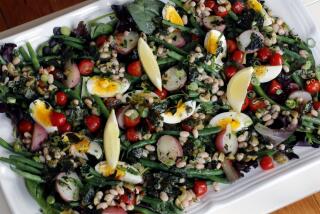The Atkins diet, updated
Dr. Robert Atkins shook up the nutrition establishment in 1972 when he published “Dr. Atkins’ Diet Revolution.” In that book and others that followed, he asserted that dieters could lose weight eating bacon, eggs, steak and rich sauces. His low-carb diet has remained controversial even as its popularity has waxed and waned through the years.
Atkins died in 2003, and three other doctors have taken up his cause with an updated Atkins diet book, published last March. More than 300,000 copies of their book, “The New Atkins for a New You,” are in print, according to publisher Fireside.
“The New Atkins” explains the four phases of the diet, starting with a two-week induction period that focuses on protein, fat and vegetables and strictly limits “net carbs.” Readers are told how to gradually incorporate more carbohydrates into their diets until they reach a maintenance phase. The book includes dieter testimonials, recipes, menu plans and tips on changing behavior.
The updated book also addresses the science behind the low-carb diet. Drs. Eric C. Westman, Stephen D. Phinney and Jeff S. Volek cite medical studies — including their own — in arguing that the diet has benefits for those concerned about obesity, cardiovascular disease and Type 2 diabetes.
Tell us what you think: Are carbs to blame? Add your own comments to the discussion. —
Not everyone agrees. “The content of the diet is inconsistent with everything we know about a heart-healthy diet,” says Dr. Robert Eckel, past president of the American Heart Assn. and a professor of medicine at the University of Colorado Anschutz Medical Campus. Eckel is concerned about “what’s in it and what’s not in it” — too much saturated fat and not enough fruits, vegetables and whole grains, he says.
We discussed the book and the diet with co-author Westman — an internist and director of the Duke Lifestyle Medicine Clinic in Durham, N.C. Our interview, edited for brevity and clarity, follows.
How did you get involved with the Atkins diet?
Back in the late 1990s, I was a doctor at the Veterans Affairs hospital here in Durham, N.C. A couple of my patients lost weight, and that was unusual because most of the time I spent telling people how to lose weight or sending them to my dietitian, it didn’t work very well.
It piqued my curiosity to see that something had worked. My patients said, “It’s just this little book; it’s the Atkins diet.” I got the book and thought, “This can’t be good for you.” One of my patients ate steak and eggs and vegetables and lost a lot of weight. The next time he came back, I checked his cholesterol because I was convinced it was going to be worse. And it was better.
So I wrote Atkins a letter. He called back and, after a brief conversation said, “Why don’t you just come up and see the clinic?” We went for a day. We saw people were losing weight. We looked over the shoulder of one of the nurses and saw chart results getting better. And so we said, “Why don’t you fund us to do a study in Durham at Duke University?” And they said OK.
What happened with the studies?
In a pilot study of 50 people over six months, there was good weight loss and improvements in blood cholesterol. But we said we really can’t call this a done deal yet. We had to do a randomized trial to make sure there wasn’t any bias in the study. We also wanted to be sure that it was a safe thing to do.
In our second study, 120 people were taught either a low-carb or a low-fat diet and followed for six months. Both groups showed improvements, but the low-carb diet did better for weight loss and metabolic syndrome [a cluster of medical factors that raises someone’s heart disease risk]. That randomized trial was published in the Annals of Internal Medicine in 2004.
How did the book come about?
Along the way, I met Steve Phinney and Jeff Volek. We’re all university professors — Steve published his first paper when I was in high school, and Jeff and I were the ones who went to Atkins in the late 1990s to ask him to fund research. When the Atkins company was thinking it wanted to redo the Atkins book with university professors, they got Steve and Jeff and myself together. We call it the “new Atkins” because essentially we’re bringing in the science that Steve has done for 30 years and Jeff and I have done for about 15 years each.
In what ways is the book different from the original Atkins diet book?
Atkins didn’t teach the “net carb” idea. That’s bringing in the low-glycemic research from experts around the world who taught us that the fiber in the foods isn’t really absorbed and has a negligible effect on the blood sugar. That opens up more options because people can have more vegetables early on.
In the most restrictive phrase, we teach people to limit their net carbohydrate grams to 20 grams. But if you include the fiber, you can eat 30 or 40 total grams of carbs. That was a new thing compared to how Atkins taught it. Atkins always included vegetables in his diet — we are just allowing more than before in the first phase — called the “induction phase.”
There are a lot of things in the book that are clarifications of things we thought hadn’t gotten out. There are four different phases of Atkins, and not everyone has to start at the most restrictive first phase. Another thing we’ve done in the book is entitle a chapter “Meet Your New Friend: Fat” because we want to dispel the notion that fat in the diet is necessarily bad for you. It’s not. We’ve included fast food restaurant options and ethnic food restaurant options to help people who are taking their meals outside the home.
But the general principle of reducing the foods that raise the blood sugar is really the science behind Atkins, and Atkins taught that from his first book.
The book also offers advice on maintaining the diet over a lifetime.
It’s sustainable when you understand that you reincorporate carbs back slowly and that you allow for delicious, nutritious foods that are low in carbs. There are many vegetables that are available and open to someone eating this way. You don’t have to have steak and bacon. Those are fine, but you can also be eating more of a Mediterranean style of Atkins if you want. You shouldn’t be bored if you’re eating Atkins. I have lots of university professors in my clinic, and they say, “This is how I ate in Europe.” So there are lots of myths and misconceptions we’re trying to overcome.
Is it possible to get too much protein and fat on this diet?
I don’t think so. What happens, when you follow it correctly, is that the body knows when to stop. When I say do it correctly, I mean eating real foods. Some people may misinterpret Atkins and start drinking lots of protein shakes and things, and that can distort your protein intake outside a healthy range. When you are eating a low-carb diet, the appetite adjusts to your body’s needs. Because you are burning the dietary fat for fuel, you can eat any kind of natural fat, even saturated fat.
You get a feeling of fullness sooner eating more protein and fat?
That’s right. You’re less hungry and you get fuller sooner.
The book also mentions options for vegetarians and vegans.
The science tells us that we want to reduce foods that raise the blood sugar in a large way. You can do that either with animal foods or with vegetable foods. As long as you pay attention to the complete proteins that are needed, you can do a vegetarian Atkins.
Can you talk a little about the process of ketosis?
What the new science tells us is that ketosis is just fine. It’s healthy. In fact, it may be optimal. A lot of people look in their textbooks — dietitians, and even doctors — and the only time it’s in there is under diabetic ketoacidosis, and they mistakenly think that’s the same thing, when it’s not. Ketosis really just means that you’re burning fat. And that’s a good thing when you’re trying to lose weight and improve your metabolism.
It’s counter to what you call the metabolic bully?
That’s right — the metabolic bully is glucose, coming from the carbs. In the body, you can burn fat or you can burn sugar — glucose. Glucose gets to the front of the line and pushes back the fat. That’s just the way our bodies are designed. It’s like the bully keeping everybody else off the swing set on the playground. There is a hierarchy in how our bodies burn the fuel, and if you’re trying to burn fat, it does not help to eat carbs.
Do people on the diet stay in this ketosis state for a lifetime, or does it gets adjusted?
If you’re older, if your metabolism is very sick, some people have to restrict the carbohydrate forever. Not everyone. Most people will be able to reincorporate carbs and go to a maintenance phase, which is not in that ketosis zone. But the maintenance phase does allow now for people staying at a low-carbohydrate level for their lifetime maintenance. Not only was Atkins right in allowing for two weeks at a low-carb level, but the science is supporting that you could stay at that level for the rest of your life.
Is this diet healthy?
Of course. I don’t use the drug terms of safe and effective anymore, I just call it a healthy way of eating. When you look at the foods that people are eating, it’s real food. We’ve been taught over the last 30 years that those foods aren’t good for you. But that teaching was actually erroneous. I highly recommend Gary Taubes’ book, “Good Calories, Bad Calories,” if you want to learn more about where the low-fat diet recommendations came from. They came out of a political subcommittee, and the science never proved that the low-fat diet was good for you. That’s not to say that some people can’t be healthy following the low-fat diet, though.
How have people’s attitudes toward the Atkins diet changed in the last decade?
The scientists who follow data are coming around. The scientists who are reading and up to date are falling in line that the low-carb diet is a viable option for obesity. In science, this is what’s called a paradigm shift. It takes a long period of time. What I see is young people who just want to find something that works will change things, because this approach works so well. The critics within the research community are not being very vocal because they know that the science is sound.
Should everybody be on this diet?
I don’t know that that would be a bad thing. It’s a healthy way of eating. What I think the science is saying is that some people must be on this diet for long-term health. Some people can eat in a variety of ways. Some are able to eat low-fat, low-carb and be healthy either way. If you have the metabolic tendency toward obesity and diabetes, then this is the way you should probably eat for optimal health. I don’t want to make the same mistake that our government made in the 1970s, which said that one diet was for everyone. I think what we’re trying to do is just make it an option for people to do it right.
Have you tried the diet yourself? Do you eat Atkins?
I do. During our first study, I saw how well people were doing. I had access to their lab results and all that. So I started to restrict the carbs in my own diet — like a lot of my colleagues who do exercise research and exercise themselves because they saw the results being so good for their patients. That is really why I continue to follow it.
Did you lose weight on the diet?
I did. About 20 pounds.
What foods do people have the hardest time giving up?
I would say No. 1 is bread, fruit is No. 2, then pasta, rice, potatoes, ice cream, candy. Those are the cravings that people have. After a few days, the cravings go away and their hunger goes down.







